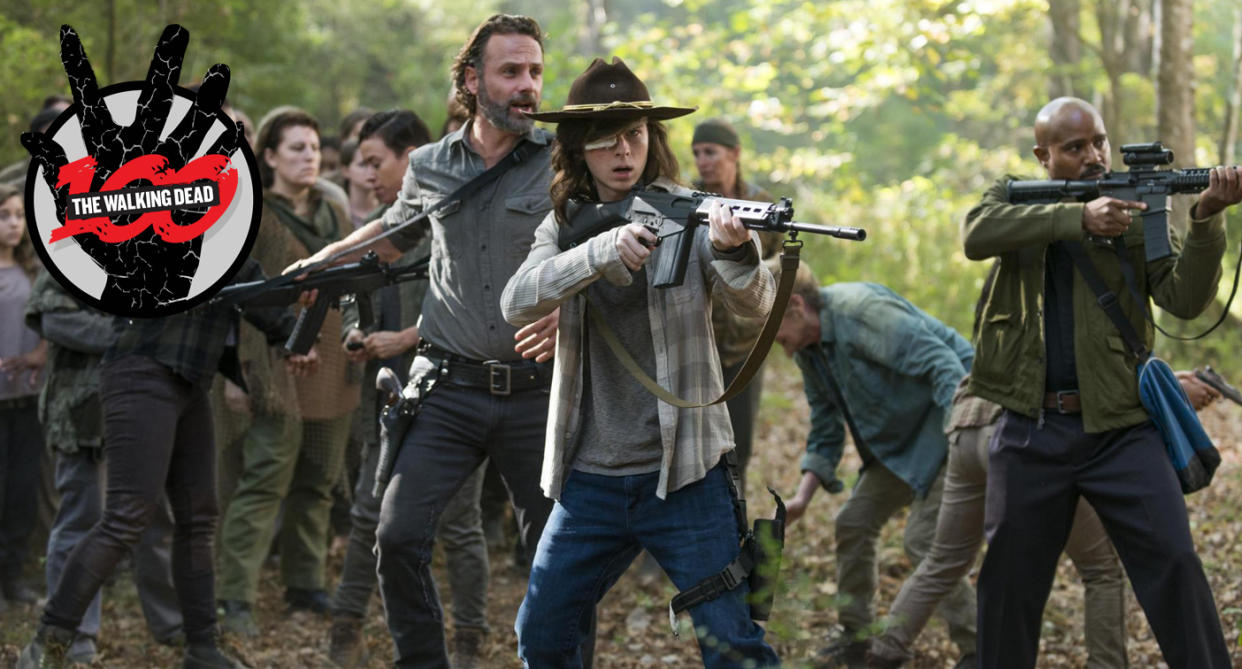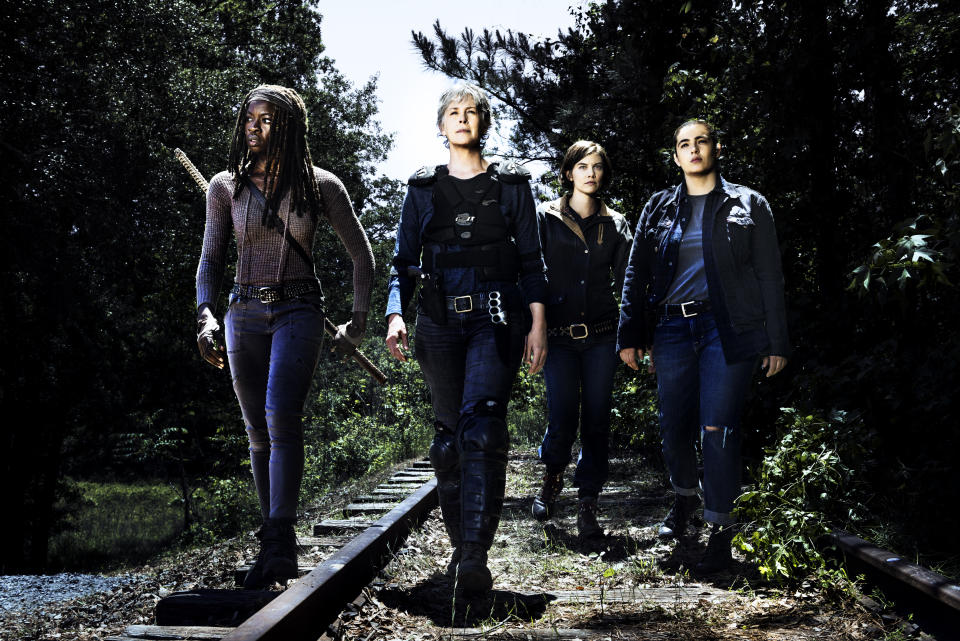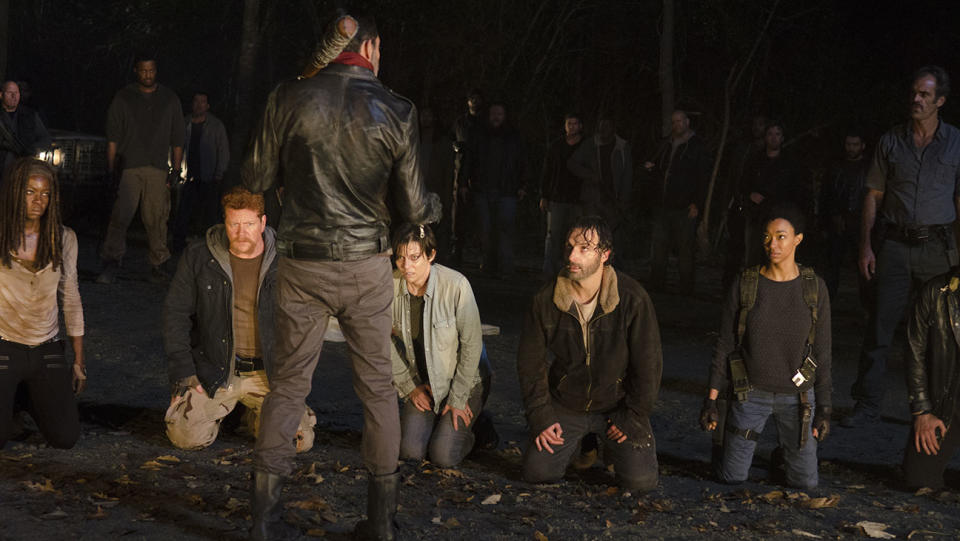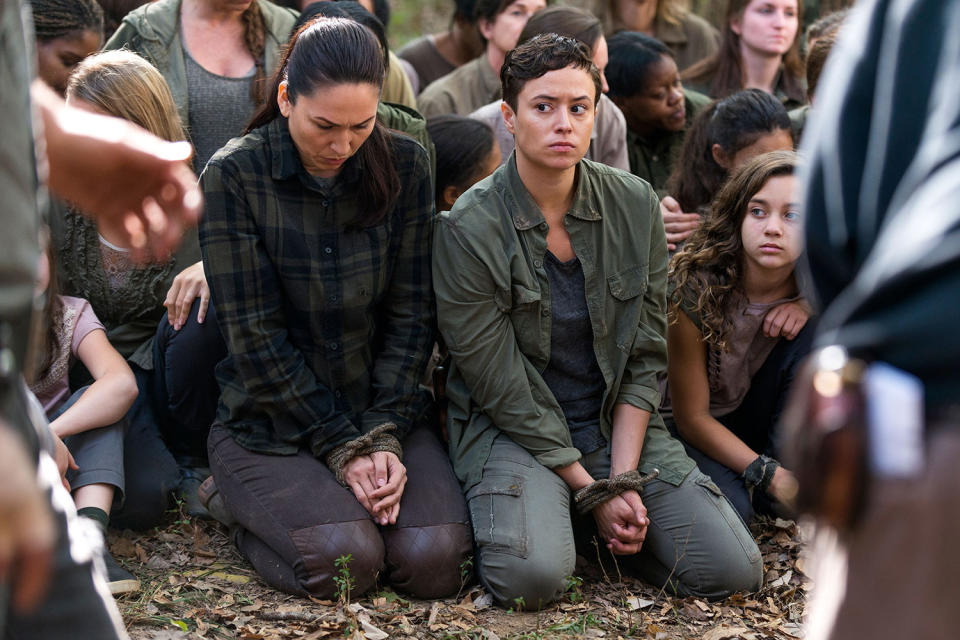'The Walking Dead' costume designer talks Season 8 battle wear, clothing the Heapsters, and why so many walkers wear skirts

To celebrate the Oct. 22 Season 8 premiere of The Walking Dead — the series’ 100th episode — Yahoo TV will be posting a new TWD-related story every day through the season opener.
If you’re already impressed with the level of detail and effort that goes into creating every episode of The Walking Dead, the series’ costume designer, Elaine Montalvo, is only going to kick that up a notch. Montalvo became TWD’s wardrobe maven at the beginning of Season 7, which means she not only began with the challenge of that deadly scene in the season premiere, but she also helped create the memorable fashions of both the Oceansiders and Jadis and her Heapsters.
Yahoo Entertainment chatted with Montalvo — who was also the costume designer for Nickelodeon’s Big Time Rush and The Bridge on FX — about outfitting multiple communities of soldiers for Season 8’s All Out War, the mind-blowing level of creativity and detail that goes into wardrobe for such a huge cast (of living and, you know, walking dead), and the fun collaboration of dressing a group like the Heapsters.
She also shares the very cool reason it may seem like a lot of female walkers are wearing skirts (and no, it’s not because of that Atlanta heat).
You jumped in with the Season 7 premiere. What did you do to prepare for this huge universe? Were you a viewer of the show? Did you read the comics?
You know, I was aware of the show, know several others who love this show. I was not a watcher of the show because it is quite intense. I’d been working on a Nickelodeon show (100 Things to Do Before High School) before The Walking Dead. I kept my mind in that world, and it was quite a different world than The Walking Dead. So, I immersed myself in the world of The Walking Dead by reading all the comics, and watching every show, and learning about each character and their journey. What attracted me the most to this particular project was the astounding amount of creativity from all the designers, and the chance to delve into the psychology of the characters, studying the sanity of the characters. It’s complex … these characters have dimension, they have flaws. And the situation that these characters are in … it’s very intriguing because it delves into the psychology of human behavior. I was first drawn to costume design to help tell stories; the development of character is what put me into this profession in the first place. I double majored at U.C. Berkeley in psychology and film studies, and got my Master of Fine Arts at the California Institute of the Arts in costume design and creative writing. So The Walking Dead is extremely creative and extremely intriguing, and I thought it was a perfect fit.
In this world in particular, the characters probably need to be as comfortable as possible in their clothes because so little else in their lives is comfortable. We’ve seen little ways they customize them, maybe also to allow them to move as freely and quickly as possible. But what are some of the other ways that the wardrobe has a psychological effect on them and plays into the storylines?
There is an aspect of functionality and environment as you mentioned. Just the fact that these characters have been through so much, and they’ve survived. And there does have to be a purpose to the clothes. [In Season 8], for example, in the event of battles that are taking place this season since our characters are at war at the moment … our characters are quite empowered. So even some of the characters that may have been a little passive in the past are becoming very confident and strong, now more than ever. And their costumes reflect that empowerment and that strength when they’re dressing for battle. You know, the boots that they wear, the types of jackets and pants. It’s all with the intention of being purposeful in the event there’s a battle. So there is a transition that some of our characters are making. And people will see that in Season 8.

What’s the wardrobe process like for you? What is a typical day like for you on the set? Do you work more on things long-term or more episode by episode?
Since I don’t have a heads up of where our characters are heading, the direction [showrunner] Scott Gimple is taking some of these characters … I get a script about seven to eight days before we start shooting. So it happens very quickly. And sometimes I’ve established an outfit on a character not knowing what lies ahead for this character, and sometimes I have to backtrack and find more multiples of an outfit because that character might … the action down the road calls for it. A typical process would be getting the script, seeing where the characters are going within their script, and then preparing for that, but also keeping in mind that this outfit might evolve in the future. I balance both the deadline and the pace of the show, the challenge of getting the show together in a very short amount of time and also wanting to or needing to present these characters in a believable way so that their clothes are always appropriate for the story at hand. And I have a wonderful costume department. We divide and conquer. And we eventually achieve what we need. But there are quite a few layers that go into the process.
How many multiples in general do you have of a certain outfit?
Well, I’ve learned to err on the side of more than less because my first episode was 701. And in the story, having all of the characters on their knees, that was a continuation of the end of Season 6, and not everybody had the multiples that we needed for the brutality that was taking place. So I had to backtrack and get five or six or even a dozen of some items. And since I custom-made them, find a fabric that’s similar, and create the shirts, and dye the shirts to look like the originals. Now I err on the side of maybe about a dozen [for each item] because there’s squibbing, which is when a character gets shot and explosions have to happen off the body. You know, that can burn through several items just for one take. So, yeah, about a dozen. It’s a safe number around here. [Laughs.]

How much of the wardrobe is purchased and customized, and how much do you create as original pieces?
I’d say I create as original pieces, maybe about 25 percent because of our time limitations. Then I’d say about half if not 75 percent of things are modified. To save time, I’ll find an item that exists in the world, but then I’ll change the pockets and the buttons, dye it a different color and add some stitching and create a story and a journey behind the garment, so that it doesn’t look like these characters were able to go to a store and just purchase it off the rack. That’s not the world that they live in. Pretty much everything needs to be customized to some degree, and given the time that we have and the casting … those very real resources would determine how much customizing I’m able to do with these pieces, but pretty much everything gets personalized.
Season 7 featured the introduction of two major new groups, the Oceansiders and the Heapsters. They each had their own very specific looks, and they weren’t characters who came from the comic book and brought expectations of how they might look. Especially with it being your first season on the show, was that more fun, and more challenging, to get to create entire looks for both those groups?
Yes, those two communities, Oceanside and the Scavengers, the Heapsters, were extra creative and exciting because there was no blueprint, as you mentioned. I started with a blank slate and Scott Gimple giving me information on these communities. It was really an extra exciting collaboration. What purpose do the costumes serve in these particular communities? For example, with Oceanside, the purpose of their clothes is to help them blend in, camouflage with the background. We went through several experiments with camouflage, from starting with some established, standard camouflage from the military and hunting worlds. And it just didn’t complete the believability of the story. So we had to adapt the designs until Scott and I landed on a very customized, pieced together, scavenged homemade camouflage. We believe that this community could have created their own camouflage from found pieces.
What is the big challenge with that? It felt like they were wearing uniforms in that their look was cohesive, but they weren’t actually uniforms, so how do you create that look, that feel, without using pre-made camouflage?
There is a very controlled color palette that Scott and I settled on. First, looking at the location where this community was going to live. I got information from our production designer and art director, and I limited myself to a very short spectrum of colors that I could allow these costumes to emerge from. I wasn’t finding enough garments that I wanted, so I over-dyed with my costumes department team. We over-dyed items until they became the colors I wanted. In some cases, I started with white garments, to really have full control of the color of these items.

Wow! All those olives and darker colors began as white shirts?
Yes, it appeared seamless, but there were several steps in controlling that world, and on top of that, we wanted the clothes to look sun bleached, because they are out in the sun and the sand. I bleached garments on the shoulders, and it added an extra sun bleached effect even on top of the controlled color palette. And using natural fibers, because they are blending into a very organic world, the cottons and linens and so forth. There are a lot of restrictions and limitations in achieving that controlled look. And it’s part of the excitement that’s the challenge. How do we achieve this? Every day, every week presents its own challenges, and we just rise to the occasion.
It’s incredible that you’ve put these limits on yourself to reach these high standards you’ve all set for the show, and that really makes it all the more impressive as a viewer; it makes me appreciate it all the more. It’s really incredible to think about anything this tough, self-sufficient, outdoor-based group wearing starting out as a white piece of fabric.
It’s hard to believe even for those of us who created the [clothes]. Like, is this really that same garment that we had two days ago, that was oh so pristine and perfect and now looks like it’s perfectly appropriate for the apocalypse?
In most cases, I start with research and a concept before we even get to putting our hands on tangible items. Scott Gimple and I share several images, from books, or online. For example, with the Scavengers, there’s a ton of emails of images that might inspire this world and that’s before we get to the process of creating our own costumes. We think about, what is the purposes of this community, what direction we’re heading, and it’s just an ever-evolving process down to the last minutes before the camera rolls. Scott might ask, “Can you replace that shoestring with wire?” It’s right before the camera rolls, and we’re still just enhancing and adding details. It’s wonderful.

For the Heapsters, the Scavengers, their looks are also cohesive, but with great individual touches. Where did you even begin with them?
The first step in creating that world came from clues from Scott. This community is artistic, but purposeful and practical. They’re survivors, but they take pride in their world and environment. They use items from their surroundings. So, for example, you’ll see aluminum from aluminum cans or bicycle chains and so forth. There’s that first conversation and the inspiration was … [people living outside], who have to use their environment to survive, and imagine the purpose of an item. And it just kept evolving from there. Then there were several experiments in creation .. “that’s a little too artistic or futuristic” … a little less futuristic, sci-fi, and a little more just purposeful. There’s a lot of restraint that we need to exercise because we’re creative people, and we want to just keep pushing that creativity. But there’s a point where we have to remember that the purpose of this costume is to help tell the story. What is that story? And so we remain anchored in that ambition and that intention.
Jadis, for example, she’s a very stoic character. She’s a very strong character. The early notes from Scott was he didn’t know if he was going to cast a man or a woman for that role, so the design started with an androgynous silhouette. There’s just something more like a statue or a column to her coat. And then once Pollyanna [McIntosh] was cast, there was even more evolution to the costume and experimentation until we got the balance just right with that artistic quality and style. There’s a purpose to her look, her boots, her gloves. All those details. And there emerged a new character.
You just mentioned her gloves, which are my all-time favorite piece of wardrobe from The Walking Dead. The gloves with the little, are those metal washers on them?
Yes, you’re right. They’re metal washers.
They are like nothing I own, but I would buy them. They’re so clever and cool, and perfectly functional in Jadis’s world.
I agree with you. I thought, what could Jadis find in her environment that she could use, but is not going to provoke action and violence? These gloves would need to serve a purpose and be strengthened. Our first experiments were with several different items, and I remember glass being one of them, but then I ended up with the washers. There’s just something so controlled about the row of washers on those gloves. Not chaotic. It’s a very controlled and graceful artistry in them. I just think “purpose.” And when Scott saw them, he said, “Yep, that’s it. That’s what we’re going to go with.” I was so happy about that, because I agreed, and because it’s one of those details that is thought through, and some people might notice it and some might not. I appreciate that you did.
The gloves are also part of Jadis and the Heapsters’ playfulness. It’s a playfulness we don’t really see with any other group, and it projects from them a kind of confidence we don’t necessarily see in any of the other groups. Those gloves are the epitome of that.
Oh, I appreciate that. I agree there is a very … there’s a clue, a hint to what these characters might have been doing before we see them and after the episode ends. There’s a life that they have that’s unique to them. We can note that. It’s refreshing to see in the apocalypse that people can still have an expression of individuality in the middle of unimaginable torment.

Definitely, that’s one of the many things that made them so interesting. I’m certainly looking forward to seeing how they factor into things in Season 8, with the war storyline. Speaking of that, the cast and producers have confirmed lots of action scenes ahead in the new season. So, basically, you had to outfit a war, for several different communities of soldiers for Season 8?
Yes. Yes. In that war, there’s a massive number of costumes, and communities and maintaining that look of a community and of a character, while still acknowledging the essence of that character … that they’ve evolved into modified looks because of the situation they’re in. And that goes for our familiar characters and new characters, the background artists we never truly get to know by script or word, but who we see that they’re ready to take on this battle and triumph or fall. It is an extra sort of excitement in getting to the mind of each character as they embark on this very trying time and rise to the occasion.
In this season, we’ve exhausted every cool jacket and shirt and pair of pants that exist in the world, because there are so many people to dress, and so many multiples, that we’re just now kind of creating our own … buying a pair of pants in one color and dying them to look like several different variations on the theme, because we have very practical limitations. For example, for some performers, I don’t want to restrict what kind of padding that they use. They ask me to have a little bit of room in them. They can’t all be those supercool tight, fitted jeans. Again, it’s the thrill and challenge of creating a very tangible world, is that we do have those limitations and it forces us to reimagine the purpose of an item. It’s not only the look, it’s, is that look available in multiples and can it serve its purpose? Will blood show on it? And the volume, for sure, that we’re dealing with this season because the war [storyline] is a very unique experience to me personally. It’s going to be exciting for the audience to see.

One thing that always strikes me is how well a lot of the characters’ clothes fit. Michonne’s pants are always a perfect fit. But do you also have to strike a balance with that? Like, not everything can fit perfectly, because tailoring is probably not a priority in the apocalypse, nor likely readily available. On the other hand, they do need things to fit well enough so that they don’t hinder them, so they’re not tripping over long hems or that sort of thing.
Yes, I do have to find that balance between the practical world the characters live in and how it affects the clothing that they wear. Since this is entertainment, I don’t want the clothes to be a distraction. If somebody were distracted by an ill-fitting pair of pants or top that a character might be wearing, that could distract from the drama of the scene. There is a fine line there for sure.
In addition to outfitting all the living, you also have to dress the walking dead, the zombies. What are some of the main challenges of that?
Well, one of the first things that [executive producer, director, and special effects whiz] Greg Nicotero discussed with me when I was being considered to join the team of The Walking Dead was that we might experiment with variations on the look of the walkers. Because sometimes in a mass scene, the herd of walkers would blend in a little too much for his appeal. So I added some variations to their clothes … warm tones like browns, which have been there from the beginning, but balancing it with some cool tones like blues, grays. Light and dark tones … prints, such as plaids and subtle florals and things like that. So you look out on a mass of walkers and there’s still a hint of individuality in there because of that controlled variation. And in general, I do approach each walker as an individual, so that I never lose sight of that humanity behind that walker. They were once like us. I create costumes with that in mind. Again, not going too far with it … if the script doesn’t call for a football player walker, I’m not going to put a football uniform in a scene, and it becomes about that.
And there’s the process of aging those clothes. All of the walker clothes are custom aged and designed here. We start with a new piece in multiples if need be. We break them in by washing them. Then we dye them, and we dye them again. And we paint on the clothes, shred the clothes. And then after the walkers go to the makeup effects department with Greg’s team, we see them once more after that so that we can complete the story. If makeup effects added very intense, gruesome bloodiness on the right side of the face, but the right side of the costume is still intact and looking really clean, we’ll continue that blood connected into the costume so the story of that walker is complete.

A lot of fans have commented that the female zombies seem to wear a lot of dresses. Is there a reason behind that?
Well, that is one of the elements of adding variation to a mass of walkers or to even a handful of walkers: finding the variation of a silhouette. So if everybody wore pants, it starts to get a little monotonous. With women, we have a little more freedom with their silhouette. Not that men don’t wear dresses and skirts, but most people recognize a dress as a female. It registers as a female. If we get the fabric of a dress or skirt flowing just right, there are so many extra movements when the wind catches that garment and blows a little bit. There’s an extra haunting movement to the walkers, so yes, we do like mixing in a few dresses and skirts for that purpose.
That is just another example of the amazing level of thought and detail you all put into your work. Can you point to one thing you’ve done so far on the show that you’re most proud of?
I guess, let’s see, Jadis and her community of Scavengers, I’m extra proud of that achievement, because it was a community that came together very quickly. I had about two weeks from the time I learned about the community to the time that they were all on camera. And every one of those garments, be they on the pronounced characters or background artists, Scott and I collaborated so closely on each one of those looks, down to the shoestrings I had mentioned, the pockets, and every detail. With my amazing department too, once we knew what we were striving for, we started gathering materials, and we achieved it. We all went to the [Scavengers’] piles on the [set] and just started gathering stuff, and we went in and did it. We literally became Scavengers. [Laughs.] It was fun.
The Walking Dead Season 8 premieres Oct. 22 at 9 p.m. on AMC.
Read more on Yahoo Entertainment:

